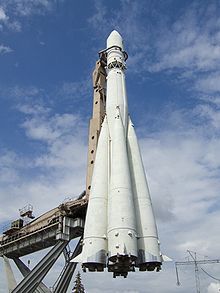Post World War II
Dornberger and Von Braun after being captured by the Allies
At the end of World War II, competing Russian, British, and US military and scientific crews raced to capture technology and trained personnel from the German rocket program at Peenemünde. Russia and Britain had some success, but the United States benefited the most. The US captured a large number of German rocket scientists (many of whom were members of the Nazi Party, including von Braun) and brought them to the United States as part of Operation Overcast.
[44] In America, the same rockets that were designed to rain down on Britain were used instead by scientists as research vehicles for developing the new technology further. The V-2 evolved into the American Redstone rocket, used in the early space program.
[45]
After the war, rockets were used to study high-altitude conditions, by radio telemetry of temperature and pressure of the atmosphere, detection of cosmic rays, and further research; notably for the Bell X-1 to break the sound barrier. This continued in the US under von Braun and the others, who were destined to become part of the US scientific community.
R-7 8K72 "Vostok" permanently displayed at the Moscow Trade Fair at Ostankino; the rocket is held in place by its railway carrier, which is mounted on four diagonal beams that constitute the display pedestal. Here the railway carrier has tilted the rocket upright as it would do so into its launch pad structure -- which is missing for this display.
Independently, in the Soviet Union's space program research continued under the leadership of the chief designer Sergei Korolev.
[46] With the help of German technicians, the V-2 was duplicated and improved as the R-1, R-2 and R-5 missiles. German designs were abandoned in the late 1940s, and the foreign workers were sent home. A new series of engines built by Glushko and based on inventions of Aleksei Mihailovich Isaev formed the basis of the first ICBM, the R-7.
[47]


No comments:
Post a Comment